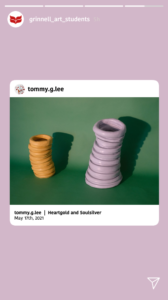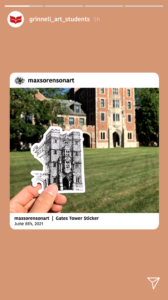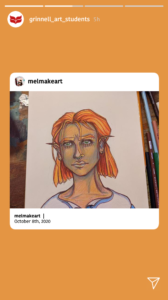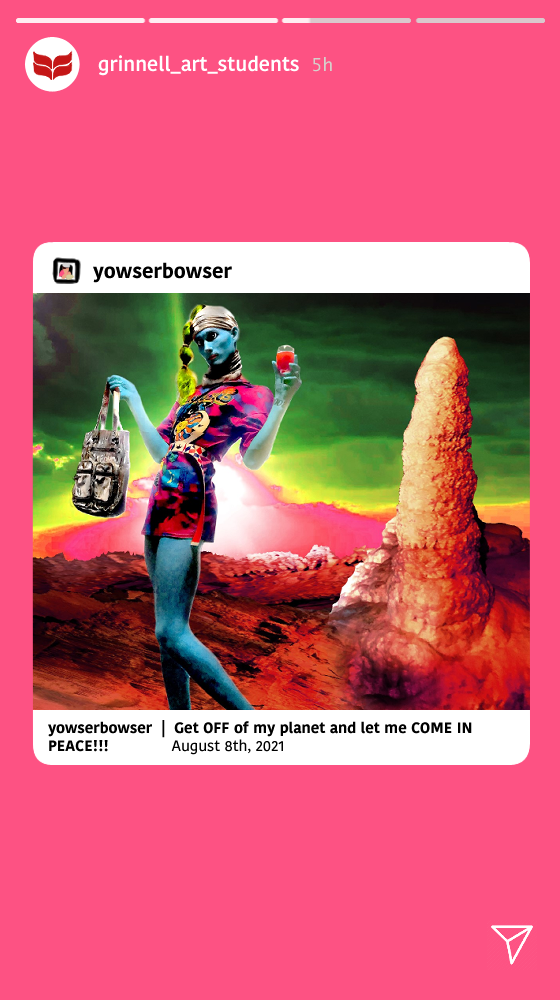Lilli Morrish
morrishl@grinnell.edu
Studio art major Tommy Lee ‘22 is tired of being put into boxes. He’s not a fan of boxes based on identities or labels, but there’s one box in particular he dislikes, and it isn’t a metaphorical one: the Instagram square.
As art becomes increasingly commodified, some artists have developed a love-hate relationship with the platform. They appreciate its hypothetical ability to show their work to the masses but get fed up with an algorithm that prioritizes quantity over quality.
“If I were to give an analogy,” said Lee, “It’s like a musician releasing an album. You can release singles, and you can share snippets of songs, but some people take … five years to release an album. I think you need a lot of alone time with your work to really evaluate what you’re making and putting out to this world.”

Lee creates nonrepresentational works in a variety of mediums, including drawing, photography, and sculpture.
The pressure to post daily, lest your account is deprioritized and left to languish at the end of someone’s feed, removes the room for exploration and failure that is key to any creative process. “If you’re going to keep creating, you have to be able to make garbage,” said Mel Johnson ‘23.
In regard to Instagram, she echoed Lee, saying, “Instead of making art, you’re making content.”
Johnson, who specializes in colored-pencil portraits, has a work style that relies on bursts of energy. While she takes creative inspiration from following other artists on the app, Instagram is not conducive to her kind-of-sporadic posting.
At the beginning of the pandemic, Max Sorenson ‘22 found himself turning to social media to share his work and connect with like-minded individuals. Sorenson posted on Instagram for the first time a week after he was sent home from Grinnell in March of 2020. He has since continued drawing daily and sharing much of that work online. He has even started selling stickers of his art via Instagram direct messaging this spring.

Despite his account being a valuable creative outlet, Sorenson shared some of the same algorithm-based criticisms of the platform as Lee and Johnson.
“Now that I feel my work shifting away from very small-scale, finish-in-a-few-days type of pieces, this schedule simply does not fit with my practice,” he wrote in an email to the S&B. “The connection of account growth with such regular posting feels troublesome at times when I would just like to be making work that [takes more than] a few days to complete.”
Peter Barth ‘22 found that quarantine gave them the space they needed to hone their creative voice.
“I felt like I got a lot more in touch with knowing what I wanted, how I wanted to be, and what I enjoyed,” they said.
Barth is a digital artist focused on Photoshop and self-portraiture. They say that while they’re not yet sure what the future holds for them as an artist, right now they feel that Instagram is the optimal outlet for sharing his work and getting input on it. This sentiment is shared by fellow digital artist Krishna Nayar ‘25.
Nayar does not plan on pursuing art as a career or major and is more focused on creative growth than algorithmic success.

“I think with my drawings,” Nayar said, “I see it as just a way to … get the attention of people and … show them, ‘Hey, here’s some of my work. Tell me what you think. Feedback’s welcome.’”
Depending on their art style, Instagram can force creatives to choose between exposure and authenticity. Nayar has started exploring time-lapse videos as a supplement to posting finished pieces, which has boosted his account engagement. As the platform increasingly moves towards highlighting videos through the traditional feed and newer “Instagram Reels” feature, digital artists and frequent posters are finding new and unorthodox ways to turn art into content.
You can check out these student artists on Instagram at their respective accounts: Lee at @tommy.g.lee, Johnson at @melmakeart, Sorenson at @maxsorensonart, Barth at @yowserbowser, and Nayar at @krishna.a.nayar.




































































